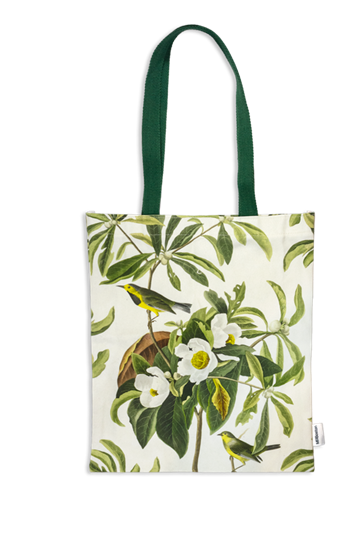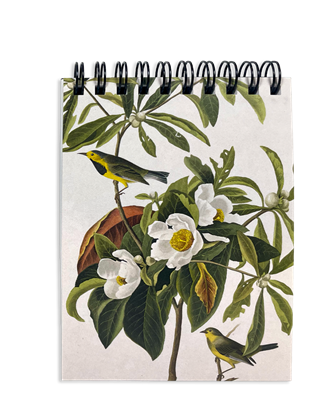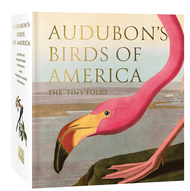John James Audubon: The Legacy of an American Visionary
May 29th 2025
John James Audubon (1785–1851) is a towering figure in the history of American art and ornithology, whose pioneering work bridged science and aesthetics in ways few had achieved before.
Renowned for his seminal publication, The Birds of America, Audubon’s art transcended mere illustration to become a profound visual testimony of the natural world. His legacy is not just confined to ornithology but extends deep into the fabric of American culture, ecology, and artistic expression.
In this article, we’ll take a look at Audubon’s work as well as highlight some of our Audubon gifts available here in our museum store.
Early Life and Formative Years
Born Jean-Jacques Audubon in Haiti to a French plantation owner and a Creole servant, Audubon was raised in France before emigrating to the United States in 1803. Though he initially pursued various commercial ventures, his enduring passion lay in the study and depiction of birds. With no formal scientific training and limited success in business, he wandered through the American wilderness, sketching birds with obsessive detail and lifelike vitality.
This unorthodox path, fueled by romantic idealism and an intense devotion to the natural world, shaped the foundation of his greatest achievements.
The Birds of America: A Monumental Work
Between 1827 and 1838, Audubon published The Birds of America, a collection of 435 hand-colored, life-sized prints of 497 bird species, etched and engraved by leading London printers such as Robert Havell Jr. The project, which took over a decade to complete, was a marvel of artistic ambition and scientific documentation.
Artistic Impact
Naturalism and Dynamism: Audubon rejected the static, taxonomic poses of earlier bird illustrations. Instead, he portrayed his subjects in motion — hunting, nesting, flying — often against richly detailed landscapes. This gave his art an unprecedented vitality and narrative quality.
Scale and Realism: The folio edition (measuring 39.5 x 26.5 inches) allowed for birds to be rendered at life size, heightening their dramatic impact and setting a new standard for both scientific and artistic representation.
Techniques and Aesthetic: Employing a blend of watercolor, gouache, pastel, and pencil, Audubon achieved remarkable detail in feathers, expressions, and environmental textures. His work fused Romantic aesthetics with empirical observation, echoing the art of contemporaries like Caspar David Friedrich and J.M.W. Turner.
Thematic Highlights in Audubon’s Work
Nature as Sublime
Audubon was influenced by the Romantic movement’s perception of nature as vast, powerful, and awe-inspiring. His depictions frequently emphasize the wildness and grandeur of the American frontier, portraying birds not merely as biological subjects but as symbols of untamed vitality.
Mortality and Survival
Many of Audubon’s illustrations subtly reflect themes of life, death, and struggle. Predator-prey interactions, nesting battles, and dramatic poses often evoke existential drama, suggesting a Darwinian view of nature long before Darwin's On the Origin of Species.
Manifest Destiny and the American Wilderness
Audubon’s work coincided with America’s westward expansion. His portrayals of wildlife in untouched settings fed into the mythos of the American frontier. However, he was also acutely aware of ecological destruction and expressed concern about habitat loss, making his work a visual archive of species and landscapes that were already beginning to vanish.
Symbolism and Meaning
Though grounded in scientific observation, Audubon’s illustrations often carried deeper symbolic meaning:
- Birds as Human Archetypes: Many viewers have noted that Audubon's birds, particularly raptors and songbirds, are imbued with human-like expressions — defiance, tenderness, aggression — elevating them to allegorical figures.
- Nature as a Mirror of Society: His portrayals often suggest parallels between natural order and human society, where beauty, violence, and survival intermingle.
- Documentation vs. Preservation: While Audubon contributed immensely to natural history, he was also a hunter and specimen collector, reflecting the paradox of Enlightenment-era science: to understand nature often meant to dominate or destroy it.
Audubon’s Influence on Art and Science
Scientific Illustration and Ecology
Audubon’s work laid the groundwork for future naturalists and illustrators. His meticulous methods and commitment to accuracy helped establish scientific illustration as a respected field. He also influenced conservation efforts, indirectly inspiring the modern environmental movement and the founding of the National Audubon Society in 1905.
American Art and Identity
Audubon helped define a distinctly American aesthetic, one rooted in wilderness, independence, and sublime nature. He inspired generations of landscape painters, including members of the Hudson River School, and his legacy is evident in the modern revival of nature-focused art.
Global Reach
Despite his American focus, Audubon's work found acclaim in Europe, particularly in Britain and France, bridging transatlantic dialogues about nature, art, and colonial exploration.
Audubon Gifts: Artistic Essentials That Honor His Work
Here in our museum gift shop, we carry numerous items that feature Audubon’s signature nature-inspired art.

Perfect for an artsy summer look, this Audubon art tote bag is the perfect addition to any bird or nature enthusiast’s wardrobe.

You’ll also find an array of stationery items and other gifts in our collection. Perhaps the most iconic, in terms of Audubon gifts, is our mini Audubon folio, echoing his larger signature work that helped establish his identity.
Audubon’s Legacy
Nevertheless, the artistic brilliance and pioneering spirit of Audubon’s work remain uncontested. His ability to blend rigorous observation with poetic expression ensured his place not only in the annals of science but also in the pantheon of great artists.
John James Audubon was more than a naturalist or painter — he was a visionary who fused art, science, and storytelling into a singular body of work that continues to captivate and educate. His art doesn’t merely depict birds; it invites viewers into a lost world where nature reigned supreme, unspoiled and majestic.
In doing so, Audubon reminds us of what we stand to lose — and what we must strive to preserve.
As environmental concerns become ever more urgent, Audubon’s work feels increasingly prescient. Through his lens, we see not only the beauty of the avian world but also the fragility of the ecosystems they inhabit, a message as powerful today as it was nearly two centuries ago.

